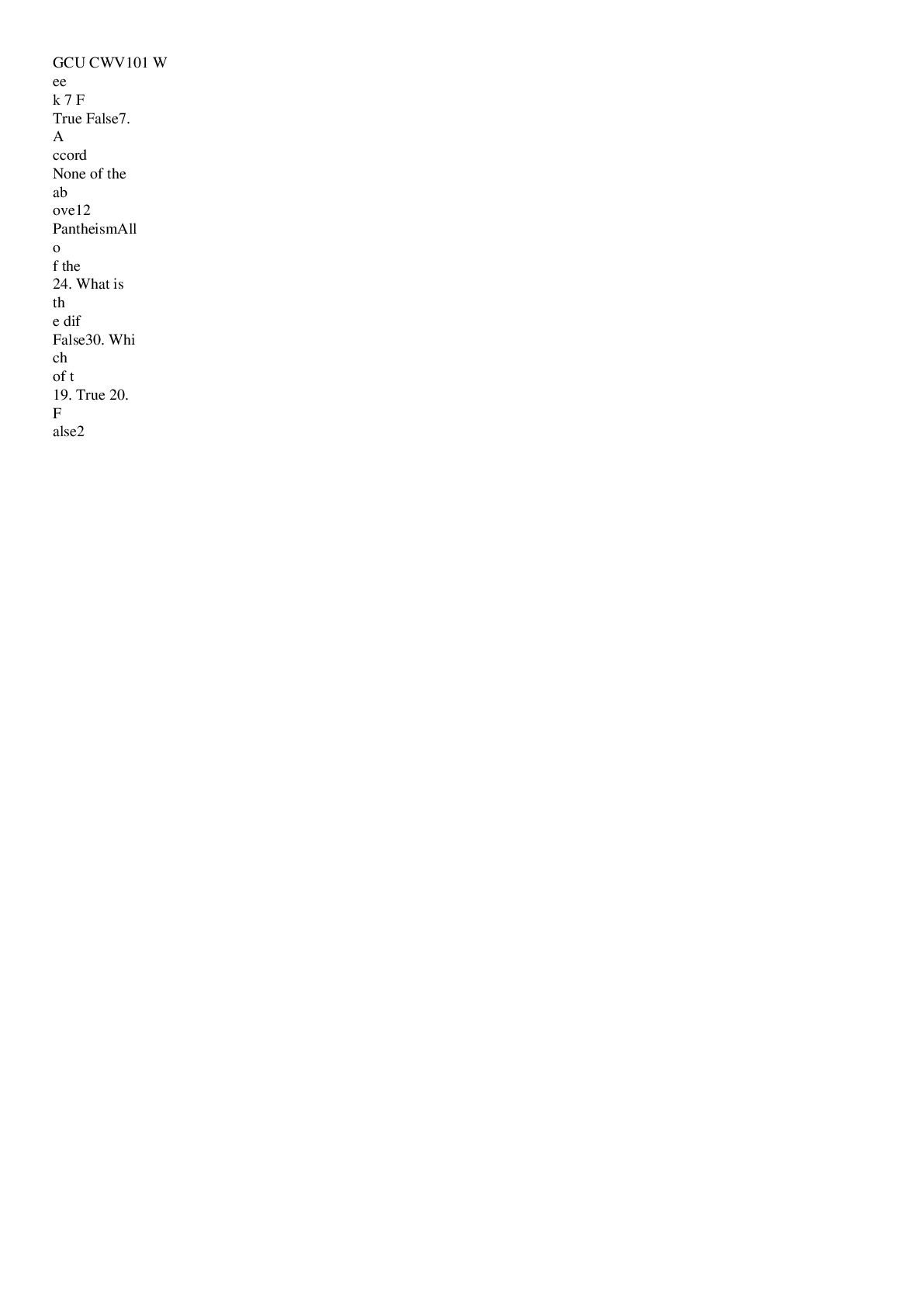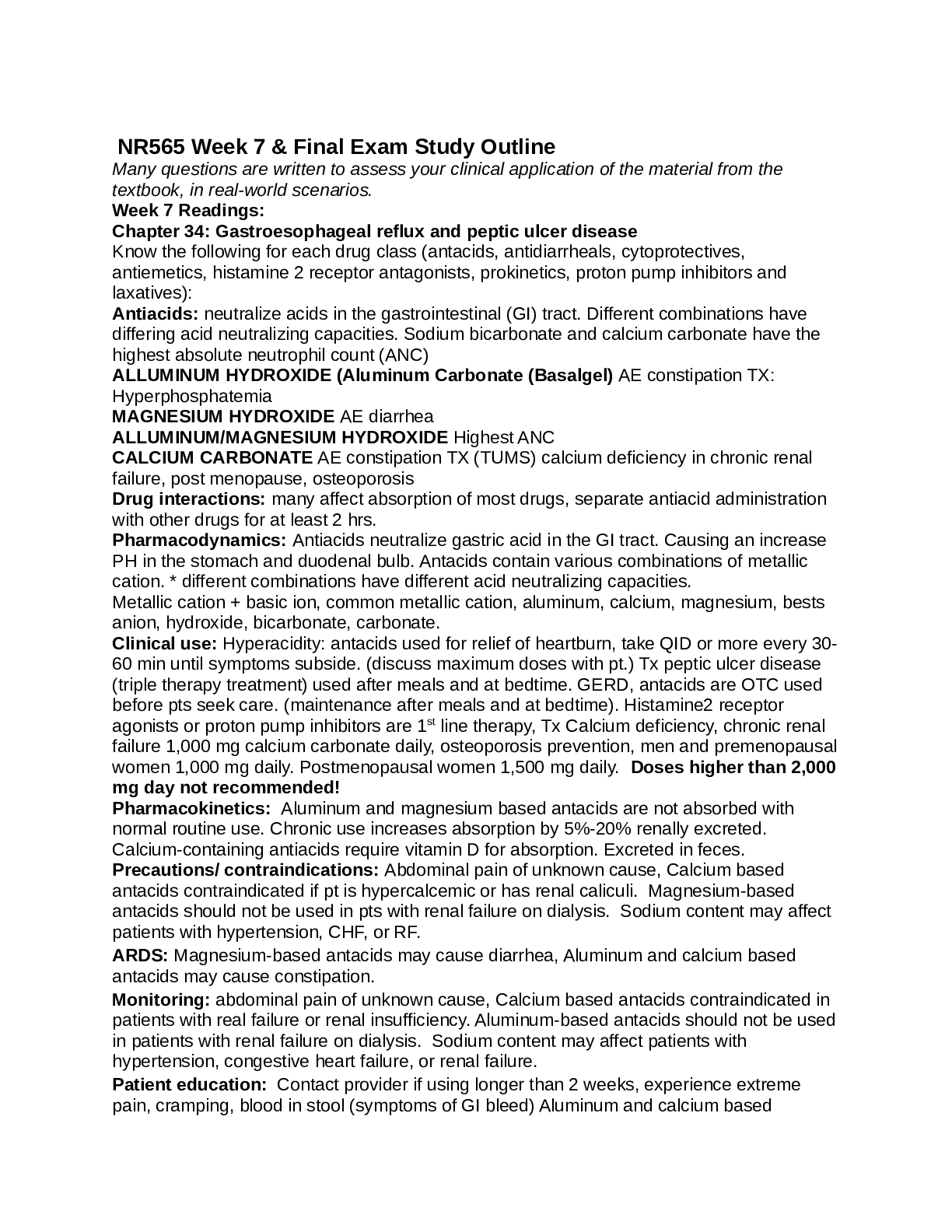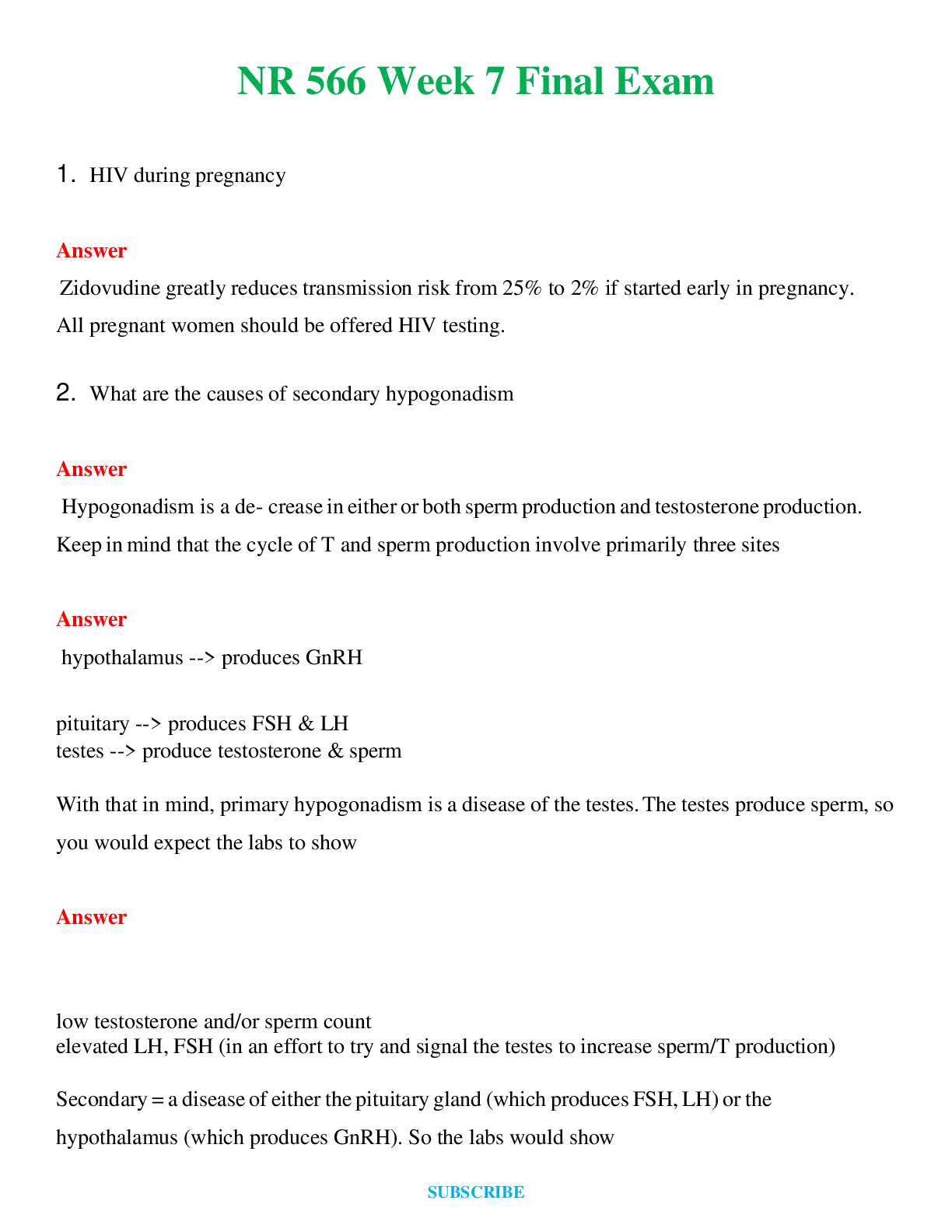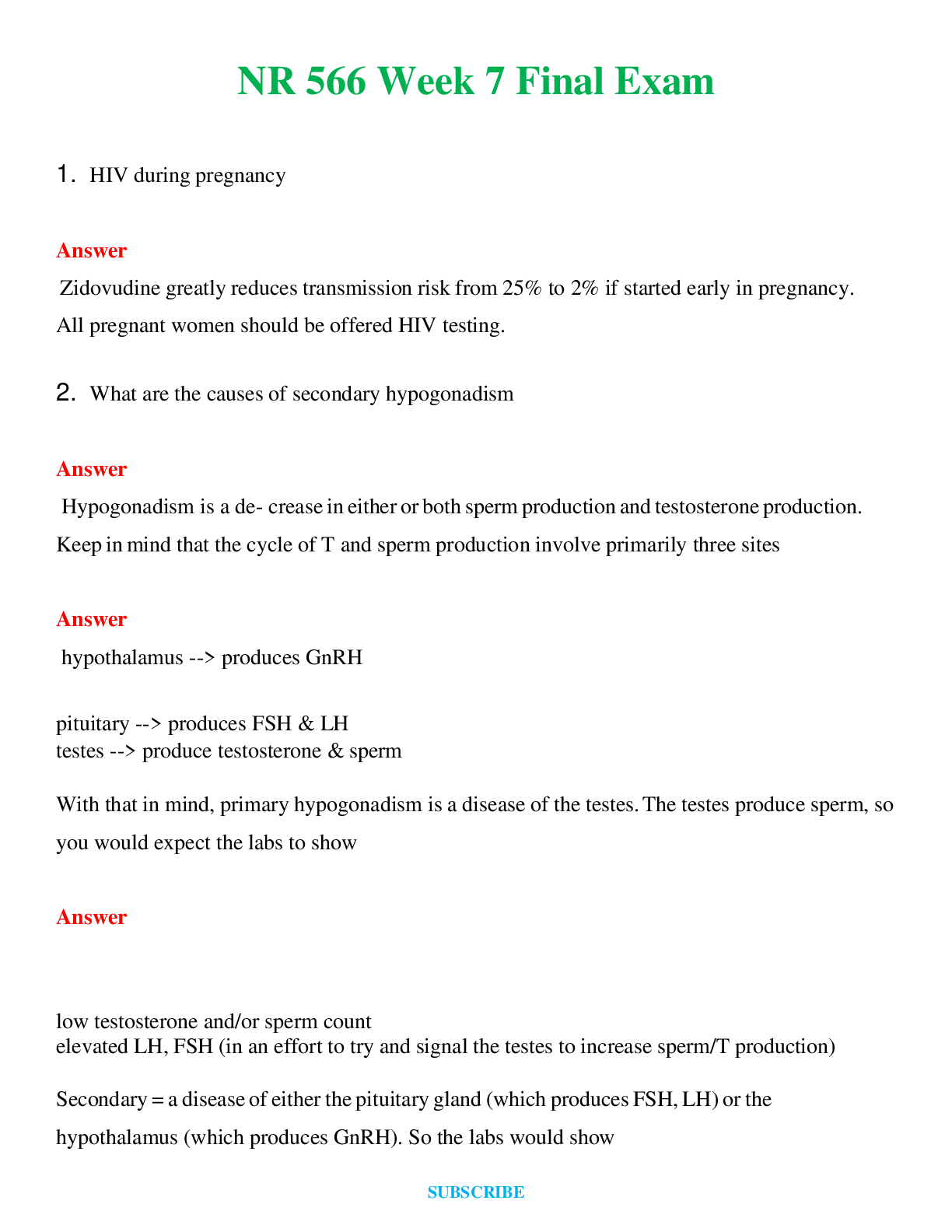NR 304 Week 7 FINAL ATI Worksheet Candice Hamby.
Document Content and Description Below
Questions: 1. Define subjective and objective data. Give three examples of each and state if the findings are documented in the history or physical examination findings. a. Subjective data: inform... ation given to you by the pt. i. pain, cramping, decreased sensation b. Objective: information that is gathered by examination and assessment i. Pallor, skin texture, capillary refill 2. List five actions a nurse should take when assessing a patient with a potentially critical hemodynamic state. Put your actions in priority order of 1-5. 1. LOC 2. RR 3. BP 4. HR 3. What does the priority setting ABC mean? How does the nurse use this mnemonic in patient assessment? If a patient has a slow or rapid respiratory rate, is airway the primary concern? a. Airway, breathing, circulation b. the nurse will assess by priority if the patient has any obstruction or abnormality with their airway, they will then assess if they can breathe or not, lastly assess if anything is wrong with their cardiovascular circulation. c. If the patient is having trouble breathing but is still breathing that may show something lodged in the airway. If nothing is seen then circulation could be the underlying problem. 4. What is HIPAA? Describe one situation when the nurse must adhere to HIPAA. a. Health Insurance Portability & Accountability Act i. Helps protect client’s medical records b. When over hearing a coworker talk about their pt. to another coworker 5. Describe the process of taking a pulse. What is a normal pulse? What are qualities of a normal pulse? What is the first action a nurse should take when the pulse is not as expected? a. Assess by palpating the surface using gentle pressure over the artery location chosen i. Normal qualities: 2+, equal in rhythm, rate, and strength, no signs of bruit or thrill b. The nurse should normally take a pulse for 30sec. and x2, if irregular or abnormal, retake the pulse for a full 1min/60sec., if irregular still take apical pulse for 1min/60sec. If pulse cannot be felt at first, Doppler may need to be used 6. What is dehydration? List three subjective and three objective findings of dehydration. List the expected vital signs of a patient who is dehydrated. a. Lack of fluid volume in your blood b. Sub: drowsiness, lightheadedness, increase thirst c. Obj: dry tongue/mucosa, sunken eyes, decreased skin turgor d. Decreased BP, increased RR/temp/HR (will be weak and thread) 7. How is fluid volume deficit related to dehydration? How would concentrations of some solutes (solids) change with dehydration? Why? a. Fluid volume deficiency involves the decrease of intravascular, interstitial, and/or intracellular fluid-which leads to dehydration: water loss without change in sodium 8. What is an undesirable response of the body to a fever? High fever Why is this undesirable? What effect does it have? Blood levels to go up 9. What is the most serious skin cancer? What is one risk factor for this cancer and one teaching item to address with your patient? Describe this most serious skin cancer below. a. Melanoma: uneven smudgy outline, may be blotchy and more than one color-brown, black, blue, red, or grey, could be raised b. Over exposure to the sun: be sure to limit your time in the sun and use sunscreen and/or clothes that cover your body well 10. In dark skinned client, where is the best area to assess for jaundice (not skin or sclera)? Best place to assess for pallor? Best place to assess for cyanosis? a. Palms of hands, oral mucosa b. Oral mucosa, lips, nailbeds, c. Oral mucosa 11. To document pitting edema, the nurse measures the following depths of pitting. What is the corresponding scale (1+, 2+, 3+, 4+ )2mm deep = ___+, 4mm deep =____+, 6 mm deep =___+, 8 mm deep = ____+ a. What is the corresponding scale (1+, 2+, 3+, 4+ )2mm deep = _1_+, 4mm deep =_2_+, 6 mm deep =_3_+, 8 mm deep = _4_+ 12. What is a body system complication for the client who is a chronic heavy drinker? Name 3 possible associated findings associated with this complication. a. Liver disease b. Jaundice, confusion, ascites 13. It is important to encourage the elderly client to continue to be as active as possible. List five complications associated with the inability to move independently. a. Bone breakdown (loss of bone density), weak bones, muscle atrophy, increase fat content, deterioration of articulating cartilage 14. Describe fluid volume overload. List a possible cause of FVO. List three signs/symptoms of FVO. a. Increase in extracellular body water b. Heart failure, cirrhosis, kidney failure c. Weight gain, pitting edema, increase BP 15. Describe fluid volume deficit. List a possible cause of FVD. List three signs/symptoms of FVD. a. Decrease of intravascular, intracellular, and interstitial fluid: dehydration b. Vomiting, diarrhea, sweating, not drinking enough water c. Decreased skin turgor, dry mucous membrane, weak, rapid pulse 16. Differentiate between oral candidiasis and leukoplakia. List one possible cause of each. a. oral candidiasis: also known as oral thrush occurs when infection develops on the inside of the mouth and on the tongue. This condition is also known as oropharyngeal candidiasis albicans fungus causes oral thrush b. leukoplakia: is a white or grey patch that develops on the tongue, the inside of the cheek, or on the floor of the mouth, it is the mouth’s reaction to chronic irritation of the mucous membranes of the mouth. Leukoplakia patches can also develop on the female genital area, however the cause is unknown. 17. What is a common manifestation that an elderly client has an acute problem such as infection or stroke a. confusion / altered level of consciousness 18. What are crackles? a. crackles are abnormal lung sounds characterized by discontinuous clicking or rattling How would you describe the sound crackles? a. Loud, low – pitch bubbling and gurgling sounds that start in early inspiration and may be present in expiration; may decrease somewhat by suctioning or coughing but reappear shortly – sounds like opening of Velcro fastener Describe two pathological conditions when the nurse would expect crackles on auscultation. a. pneumonia b. CHF 19. What are wheezes? a. A wheeze (formally called “sibilant rhonchi”) is continuous, coarse, whistling sound produced in the respiratory airways during breathing. For wheezes to occur, some part of the respiratory tree must be narrowed or obstructed, or airflow velocity within the respiratory tree must be heightened. How would you describe the sound of wheezes? a. High pitched, musical squeaking sound that sounds polyphonic (multiple notes as in a musical cord) predominate in expiration but may occur in both expiration and inspiration Describe two pathological conditions when the nurse would expect wheezes on auscultation. a. acute asthma b. Chronic emphysema 20. What is the significance of a syncopal episode in the elderly client? a. normally a cardiac issue/ stimulation of the vasovagal response when medication is inserted rectally / when an elderly client bares down too hard to have a bowel movement 21. Describe the subjective and objective findings of a client with a pneumothorax. -Trapped air in the pleural space -A large part of the lung or complete lung collapse can result in unequal chest expansion -SOB, decreased O2 saturation -May hear hyperresonance -Tension pneumo => tracheae deviation -Trauma may result in Sub Q emphysema (trapped air under the skin that feels like cackling/popping) -May have pain on inspiration 22. Describe the subjective and objective findings of a client with a pulmonary embolus. • Sharp, stabbing pain worsening with deep breaths, dyspnea • Pain can be experienced in chest, back, shoulder, or upper abdomen 23. Describe the subjective and objective findings of a client with pneumonia. • Sharp or stabbing pain associated with cough • Mostly generalized to one side of chest but can have upper abdominal pain • Fine crackles 24. Describe the subjective and objective findings of a client with emphysema. • Decreased breath sounds. May have prolonged expiration. Muffled heart sounds resulting from overdistention of lungs • Increased AP diameter. Barrel chest. Accessory muscles used to aid respiration. Tripod position. SOB, especially on exertion. Respiratory distress. Tachypnea. Wheeze • Symptoms include shortness of breath, wheezing, or a chronic cough 25. Describe the subjective and objective findings of a client with a myocardial infarction. • Heaviness; viselike, squeezing, crushing, tightness; vague, burning, constricting, or pressure; poorly localized pain lasting 20-30 minutes to hours and does not resolve with rest 26. Describe the subjective and objective findings of a client with congestive heart failure • Shortness of breath, swelling, fatigued, coughing, rapid weight change, pain in chest 27. Describe the subjective and objective findings of a client with a suspected stroke or TIA. List at least three assessments a nurse will perform for a suspected stroke or TIA. • Headache, dizziness/vertigo, seizures, tremors, weakness, incoordination, numbness or tingling on one side, difficulty swallowing and speaking • Three assessments: mental status, check cranial nerves, check motor function 28. What is a murmur? What does a murmur indicate? How does the nurse describe the sound of a murmur? What are the subjective findings of a patient with a murmur? How does the nurse assess for a murmur? • · A murmur is a gentle, blowing, swooshing sound that can be heard on the chest wall • · Indicates: Velocity of blood increases (flow murmur) (e.g., in exercise, thyrotoxicosis), a stenotic or narrowed valve, an incompetent or regurgitant valve, Viscosity of blood decreases (e.g., in anemia) • · The nurse would use the bell of the stethoscope to assess for a murmur • · Subjective: dyspnea 29. Describe PAD. List three subjective and three objective findings of the client with PAD. • · Peripheral artery disease (PAD) affects noncoronary arteries and usually refers to arteries supplying the limbs. • Intraluminal flow is decreased due to plaque. This reduces blood flow to extremities • Results in ischemia or inadequate blood supply • Risk factors: Increasing age, atherosclerosis, hypertension, smoking, diabetes, male gender and obesity • Subjective: Recurrent leg pain, cramping, and decreased sensation • Objective: Pale, cool, shiny, thin textured skin, sluggish capillary refill, decreased hair, thickened toenails, presence of painful non-bleeding arterial ulcer that are slow to heal and may be black • DANGLE LEGS 30. Describe PVD. List three subjective and three objective findings of the client PVD. • Incompetent valves result in varicosities (varicose veins) • Leads to pooling and edema • ELEVATE LEGS • Increased risk for venous stasis ulcers, deep vein thrombosis (DVT) • Risk factors: sitting or standing for long periods of time, bedrest, genetic history, female, obesity, late pregnancy, tall stature, increasing age • Subjective: Dull aching, heaviness, or leg cramping, itching and tingling, pain that is worse when standing, pain that gets better when legs are raised. Leg swelling. May have weeping if severe edema • Objective: Edema, hyperpigmentation changes (red or brown) around ankles, superficial varicose veins, thickening and hardening of skin on legs and ankles. Texture is thickened 31. Describe DVT. List three subjective and three objective findings of the client with DVT. • Thrombus or clot often in the arm or leg • Usually results in thrombophlebitis • Clot may form due to venous stasis • Bedrest increases the risk of venous stasis and DVT • Subjective: UNILATERAL pain, swelling, redness and warmth, leg cramps • Objective: Swelling, inflammation, Bluish or whitish discoloration of skin. 32. List three subjective and three objective findings of the client with an infection of the hand from a dog bite. • Subjective: swelling, redness, or pain • Objective: fever, malaise, pus/drainage 33. Describe the sequence of abdominal assessment (and why this is different from the normal sequence of assessment techniques). • Inspect, Auscultate, Percussion, and Palpate • Palpation is last to avoid any extra bowel movements 34. Describe at least two different descriptions of emesis of the client with bleeding gastric ulcer. • Blood, brownish and/or "coffee ground" in color. 35. Describe the stool color of a client with a bleeding gastric ulcer. • Bleeding ulcer may result in black, tarry blood 36. Describe the stool color of a client with a bleeding sigmoid tumor. • Bright red 37. What is the significance of low-grade fever in the client with pain over McBurney’s point? • It would be a sign of appendicitis 38. Describe three subjective and three objective findings of the client with appendicitis. • Subjective: pain in periumbilical region that later shifts to severe, sharp, persistent pain and tenderness localized in RLQ • Objective: Fever, What is a positive Blumberg’s sign? What is rebound tenderness? • A positive Blumberg’s sign is pain on release of pressure • Assess rebound tenderness when the person reports abdominal pain or when you elicit tenderness during palpation. Choose a site away from the painful area. Hold your hand 90 degrees, or perpendicular, to the abdomen. Push down slowly and deeply; then lift up quickly. This makes structures that are indented by palpation rebound suddenly. A normal, or negative, response is no pain on release of pressure 39. What is peritonitis? Describe at least three conditions that result in peritonitis. • Inflammation of the membrane lining the abdominal wall and covering the abdominal organs • Could result from perforation of any abdominal organ or contamination of the abdominal cavity. 40. What is diverticular disease? • Diverticular disease is the general name for a common condition that causes small bulges (diverticula) or sacs to form in the wall of the large intestine (colon). Where is the client likely to have discomfort? • Cramping in the LLQ, radiates to back What foods should the client who has diverticular disease avoid? • Fiber rich diet 41. Compare and contrast Cullen’s sign and Grey Turner’s sign. What is the significance of each? • Cullen’s Sign: Ecchymosis or bruising around umbilicus can indicate intra-abdominal bleeding (Ruptured ectopic pregnancy or pancreatitis) • Grey Turner’s Sign: Grey Turner's sign refers to bruising of the flanks, the part of the body between the last rib and the top of the hip. The bruising appears as a blue discoloration, and is a sign of retroperitoneal hemorrhage, or bleeding behind the peritoneum, which is a lining of the abdominal cavity. 42. Define osteoporosis. What are risk factors for osteoporosis? Name three wellness-teaching elements to include in the care of the client with osteoporosis. • results in decrease in bone density, more porous bones/weaker bones • Risk factors: Increased risk of fractures – Hip, wrist, and spine; obesity; • Fast walking is the best prevention for osteoporosis • including eating a well-balanced diet, engaging in regular exercise, avoiding smoking, and limiting alcohol intake; but at the top of the list is getting enough calcium and vitamin D. 43. Define scoliosis and the physical findings noted on inspection. - Scoliosis is a sideways curvature of the spine that occurs most often during the growth spurt just before puberty. - Physical findings noted on inspection are: - Patient bends over and S-shaped curvature of the spine indicates scoliosis. - Uneven shoulders and scapular height - Unequal hips - Rib interspaces flared on convex side - If severe, deviation is present 44. Define kyphosis and the physical findings noted on inspection. - Kyphosis is the forward curvature of the upper back (humpback) that is very common in older people. - Physical findings noted on inspection are: - Humpback - Severe back pain - limited mobility - Hyperextension of neck (if neck muscles are strong) to compensate of head being maintain level of vision 45. Define lordosis and the physical findings noted on inspection. - Lordosis is the excessive inward curving of the lower back (lumbar and cervical spine). - Physical findings noted on inspection are: - Increased concave shape of spine - Swayback - Weight shifts back to compensate for enlarging fetus 46. What is a concern for the client who has repetitive wrist movements in the workplace over many years? - Carpal Tunnel. 47. Describe the findings of a client with an arm fracture. - Pain, swelling, tenderness - Bruising in upper arm - Limited ROM in arm and shoulder 48. Describe the findings of a client with a dislocation - Result in severe pain - Inability to move extremity 49. Describe the findings of a client with a rotator cuff tear - Extremity has decreased ROM - Severe pain with movement 50. Describe the findings of a client with a hip fracture. - Result in increased in sharp pain with movement - May have deformity and edema 51. Compare and contrast osteoarthritis and rheumatoid arthritis - Rheumatoid arthritis: - Systemic inflammatory disease results in pain and stiff joints; affects hands and feet bilaterally. - Can occur at any age- more common after 55. - Stiffness is worse in the morning and after periods of rest. - Warmth makes it better (warm shower) - Moving around makes it better. - May take NSAIDS and celecoxib. - Osteoarthritis: - Degenerative Joint Disease (DJD). - Chronic damage to cartilage - Worse later in the day and following activity. - Increased in Obesity. - Common in hip and knee - Most common hip dysfunction is limitation of internal rotation. - Worse with weight bearing. - Knee has pain with weight bearing and stairs. 52. Know the assessment of the cranial nerves assessed most frequently in the acute care setting (hospital); Cranial nerves II, III, IV, VI, VII, IX, X – optic, oculomotor, trochlear, abducens, facial, and gag reflex. - CN II: Snellen Chart - CN III, IV, VI: PERRLA - CN VII: Smiling, Frowning, Raising eyebrows - CN IX & X: Gag reflex 53. List three common findings in the client with meningitis. - Fever - Headache - Neck Stiffness 54. Describe the function of the Glascow Coma Scale. - The function of the Glascow Coma Scale is a neurological scale to assess LOC after a brain injury. What is the minimum score? What is a normal score? - Minimum Score is: 3 - Normal Score is: 13 or higher What score would the nurse be concerned about the ability of the patient to protect the airway? - 3 55. What is a complication of diabetes and/or inadequate circulation to the extremities that results in decreased sensation? How can the nurse use this information to teach the patient about potential safety issues to avoid injury and wound complications? - Peripheral neuropathy of hands and feet. - Managing blood glucose to help delay or prevent nerve damage - Healthy lifestyle and diet. 56. You are teaching a woman about self-breast examination. How often will you teach that breast self-examination be performed? Each month (5 days after mensies) When will you suggest the woman perform the self-breast exam? In front of the mirror with good lighting or can be done in the shower. Describe palpation technique for self-breast exam. Can be in the shower for easier palpation; light palpation, but firm. Where is the most important area of the breast to include? Around the outer rim of breast and up towards axillary tail of spence 57. List a concern of the post-menopausal woman with vaginal bleeding. - Polyps - Cancer 58. Describe what a white curd-like discharge indicates in a woman who receives antibiotics for a urinary tract infection? - Yeast Infection 59. You are teaching a young man about self-testicular examination. How often will you tell the man that the testicular self-exam performed? Monthly When will you suggest the exam be performed? Warm Shower How much pressure is used during the exam and what will the testicle normally feel like? Gentle pressure What finding should be reported to the health care provider? Smooth, Firm, and Rubbery 60. Compare and contrast benign prostate hypertrophy and prostate cancer - Benign Prostate Hypertrophy: - Subjective: urinary frequency, urgency, hesitancy, straining to urinate, weak stream, intermittent stream, sensation of incomplete emptying, nocturia. - Objective: a symmetric nontender enlargement; commonly occurs in males beginning in the middle years. Prostate surface feels smooth, rubbery, or firm (like consistency of the nose, with the median sulcus obliterated. - Prostate Cancer: - Subjective: frequency, nocturia, hematuria, weak stream, hesitancy, pain or burning on urination; continuous pain in lower back, pelvis, thighs. - Objective: A malignant neoplasm often starts as a single hard nodule on the posterior surface, producing asymmetry and a change in consistency. As it invades normal tissue, multiple hard nodules appear, or the entire gland feels stone-hard and fixed. Median sulcus is obliterated. 61. Compare and contrast acute and chronic renal failure. - Acute Renal Failure: - Occurs sudden when kidneys are unable to filter waste from your blood. - Develops rapidly over a few hours or few days. - Most common in already critically ill patients in the ICU - SOB, fatigue, confusion, nausea, seizures, fluid retention, drowsiness, decreased urine output. - Chronic Renal Failure: - Gradual loss of kidney function. - Once in advanced stage, electrolytes, high levels of fluid, and wastes can build up in in body. - Nausea, vomiting, loss of appetite, fatigue and weakness, sleep problems, changes with how one urinates, muscle twitches/cramps, hypertension (hard to control), SOB if fluid levels continue to build up in lungs. 62. What lab findings are consistent in a client with chronic renal failure? - Lab findings consistent in a client with chronic renal failure are: BUN, Creatine Serum, Hyperkalemia. 63. Why is the female more at risk for urinary tract infections compared to a male? - Females have a shorter urethra. 64. What are three subjective and three objective findings of the client with a urinary tract infection (UTI)? - Subjective Findings: - Pelvic pain in women - Strong smelling odor - Burning sensation when urinating - Objective Findings: - Fever - Urine Culture for bacteriuria, pyruia - Cloudy Urine [Show More]
Last updated: 2 years ago
Preview 1 out of 12 pages
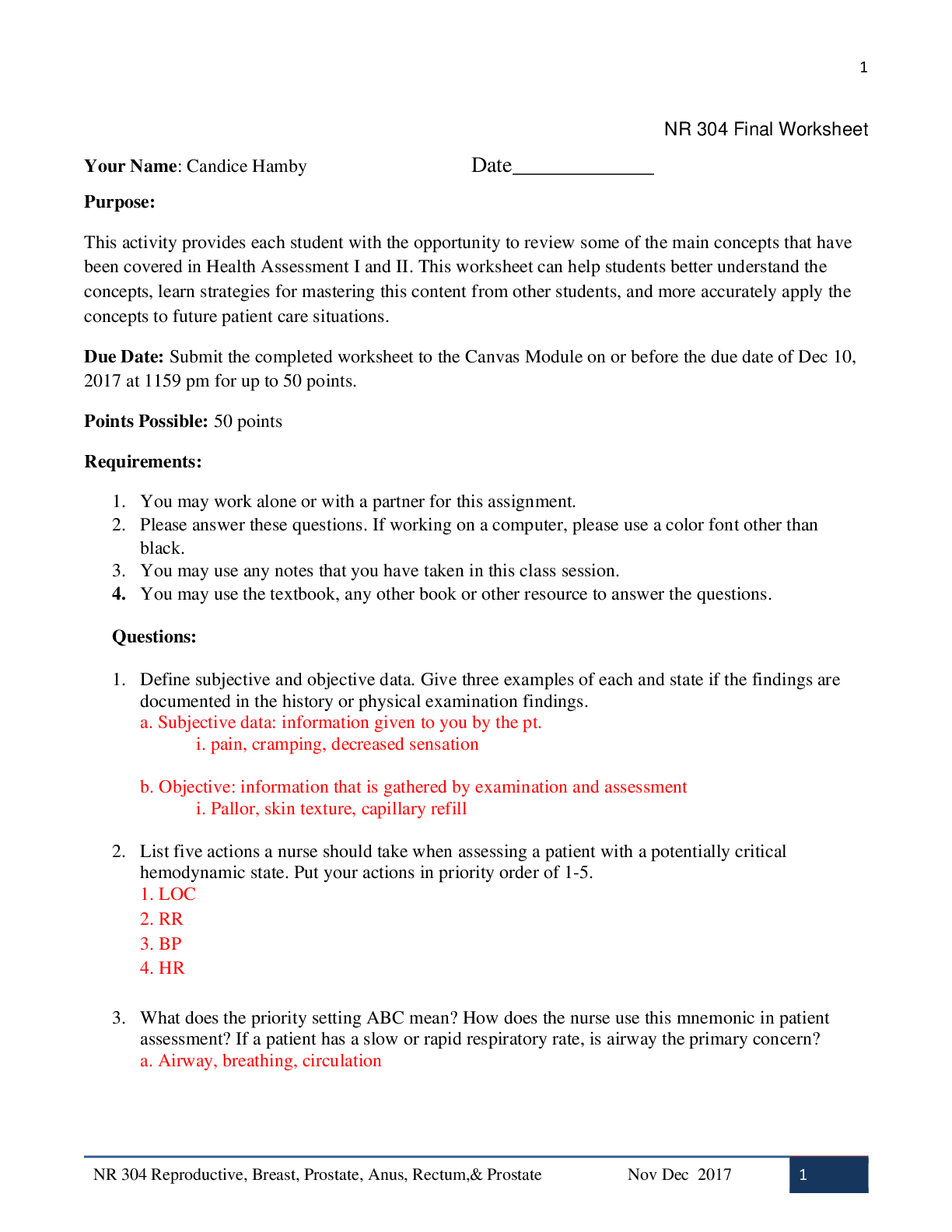
Buy this document to get the full access instantly
Instant Download Access after purchase
Buy NowInstant download
We Accept:

Reviews( 0 )
$14.00
Can't find what you want? Try our AI powered Search
Document information
Connected school, study & course
About the document
Uploaded On
Feb 22, 2021
Number of pages
12
Written in
Additional information
This document has been written for:
Uploaded
Feb 22, 2021
Downloads
0
Views
50

.png)





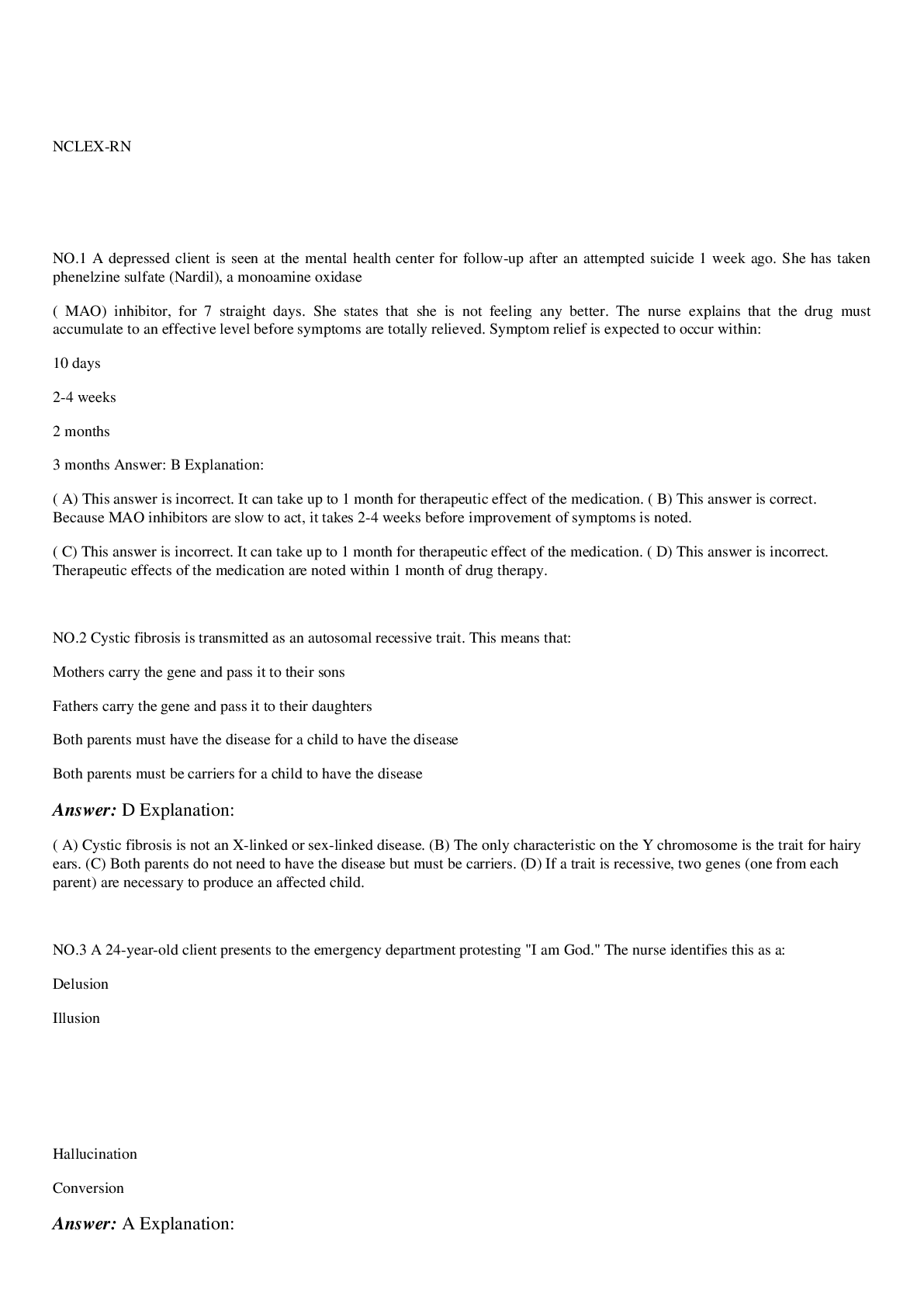
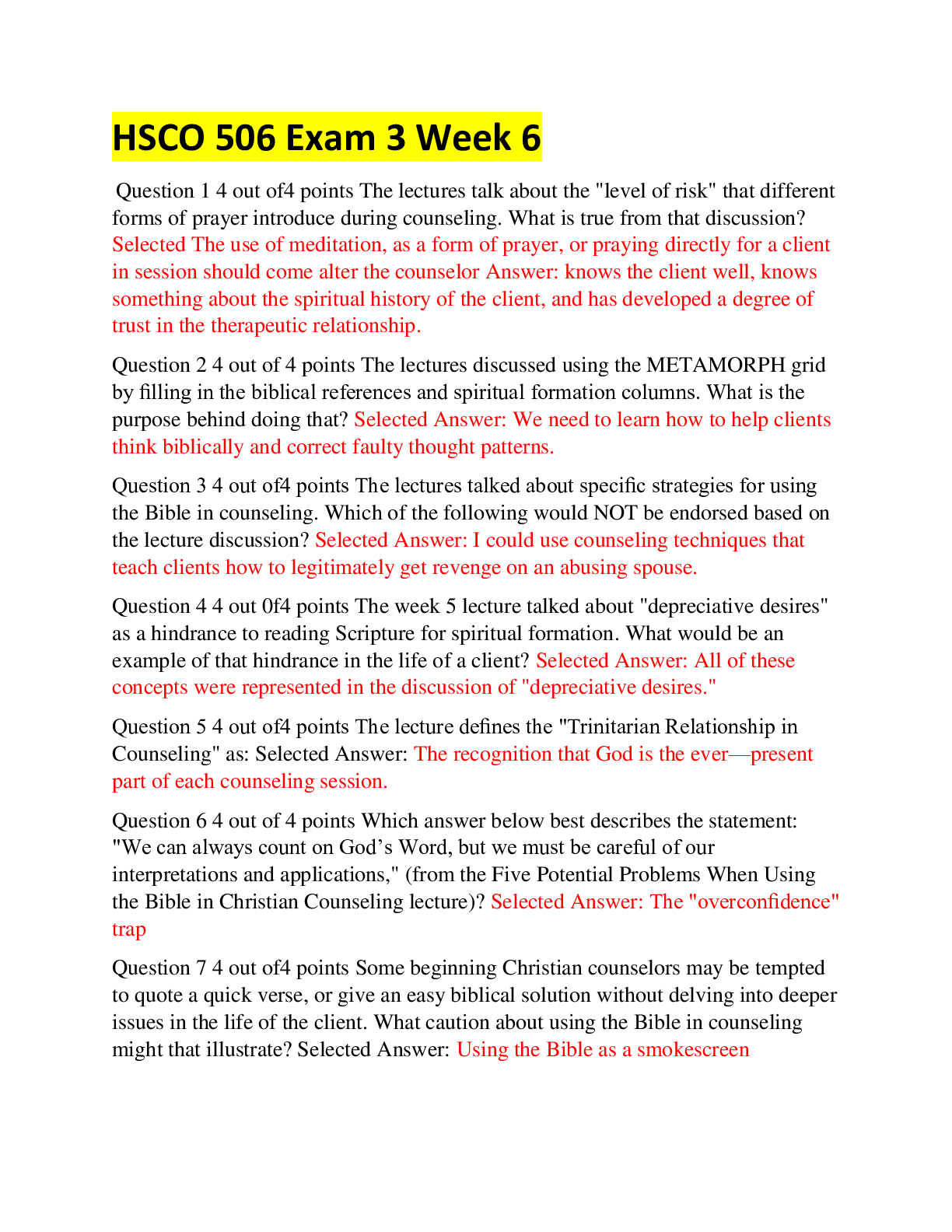

.png)



